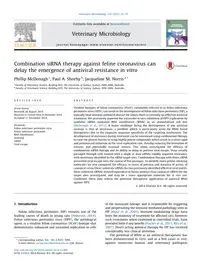
2015 Combination siRNA therapy against feline coronavirus can delay the emergence of antiviral resistance in vitro PDF
Preview 2015 Combination siRNA therapy against feline coronavirus can delay the emergence of antiviral resistance in vitro
Combination siRNA therapy against feline coronavirus can delay the emergence of antiviral resistance in vitro Phillip McDonagh a, Paul A. Sheehy b, Jacqueline M. Norris a,* a Faculty of Veterinary Science, Building B14, The University of Sydney, Sydney, NSW 2006, Australia b Faculty of Veterinary Science, Building B19, The University of Sydney, Sydney, NSW 2006, Australia 1. Introduction Feline infectious peritonitis (FIP) remains one of the leading causes of death in young cats (Pedersen, 2014). Feline infectious peritonitis virus (FIPV), the aetiological agent, is a virulent feline coronavirus (FCoV) biotype that demonstrates enhanced and sustained replication in cells of the monocyte lineage, and is responsible for triggering and perpetuating the immune mediated pathology seen in FIP (Kipar et al., 2005). Immune modulating drugs have been the mainstay of treatment for affected cats, however such treatments when examined in controlled trials, have provided little if any benefit (Fischer et al., 2011; Ritz et al., 2007). Direct acting antiviral therapy for FIP has received considerably less clinical attention. The potential of RNAi as an antiviral therapeutic has been demonstrated in vitro, and in a few cases in vivo, against numerous human and veterinary pathogens Veterinary Microbiology 176 (2015) 10–18 A R T I C L E I N F O Article history: Received 28 August 2014 Received in revised form 8 December 2014 Accepted 11 December 2014 Keywords: Feline infectious peritonitis virus Feline infectious peritonitis RNA interference Antiviral siRNA Viral escape A B S T R A C T Virulent biotypes of feline coronavirus (FCoV), commonly referred to as feline infectious peritonitis virus (FIPV), can result in the development of feline infectious peritonitis (FIP), a typically fatal immune mediated disease for which there is currently no effective antiviral treatment. We previously reported the successful in vitro inhibition of FIPV replication by synthetic siRNA mediated RNA interference (RNAi) in an immortalised cell line (McDonagh et al., 2011). A major challenge facing the development of any antiviral strategy is that of resistance, a problem which is particularly acute for RNAi based therapeutics due to the exquisite sequence specificity of the targeting mechanism. The development of resistance during treatment can be minimised using combination therapy to raise the genetic barrier or using highly potent compounds which result in a more rapid and pronounced reduction in the viral replication rate, thereby reducing the formation of mutant, and potentially resistant viruses. This study investigated the efficacy of combination siRNA therapy and its ability to delay or prevent viral escape. Virus serially passaged through cells treated with a single or dual siRNAs rapidly acquired resistance, with mutations identified in the siRNA target sites. Combination therapy with three siRNA prevented viral escape over the course of five passages. To identify more potent silencing molecules we also compared the efficacy, in terms of potency and duration of action, of canonical versus Dicer-substrate siRNAs for two previously identified effective viral motifs. Dicer-substrate siRNAs showed equivalent or better potency than canonical siRNAs for the target sites investigated, and may be a more appropriate molecule for in vivo use. Combined, these data inform the potential therapeutic application of antiviral RNAi against FIPV. � 2014 Elsevier B.V. All rights reserved. * Corresponding author. Tel.: +61 2 9351 7095. E-mail address:
